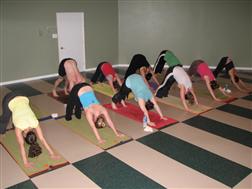by Answer is Fitness on September 20, 2011
 During the course of an average mile run, your foot will strike the ground 1,000 times. The force of impact on each foot is about three to four times your weight. So of course runners complain of bad backs and knees, tight hamstrings, and sore feet.
During the course of an average mile run, your foot will strike the ground 1,000 times. The force of impact on each foot is about three to four times your weight. So of course runners complain of bad backs and knees, tight hamstrings, and sore feet.
This pain is not from running alone, but from the imbalances caused by running. If you bring your body into balance through the practice of yoga, you can run long and hard for years to come. Yoga and running lie on opposite ends of the exercise spectrum, but they are not mutually exclusive. They actually make a good marriage of strength and flexibility.
Striking a Balance
Those who only run are most likely structurally balanced people who can handle the physical stresses of the workout with minimal discomfort. Yet, many runners don't survive the imbalances that running introduces. Often, they suffer from chronic pain and are sidelined by injury.
A typical runner experiences too much pounding, tightening, and shortening of the muscles and not enough restorative, elongating, and loosening work. Without opposing movements, the body will compensate to avoid injury by working around the instability. Compensation puts stress on muscles, joints, and the entire skeletal system.
If you're off balance, every step you take forces the muscles to work harder in compensation. Tight muscles get tighter and weak muscles get weaker. A tight muscle is brittle, hard, and inflexible. Because muscles act as the body's natural shock absorbers, ideally they should be soft, malleable, and supple, with some give. Brittle muscles, on the other hand, cause the joints to rub and grind, making them vulnerable to tears.
Sport specific training causes muscle rigidity. This causes a structurally out of shape and excessively tight body.
The internal focus of Yoga centers your attention on your own body's movements rather than on an external outcome. Runners can use yoga to balance strength, increase range of motion, and train the body and mind. Yoga poses move your body through gravitational dimensions while teaching you how to coordinate your breath with each movement. The result is that your body, mind, and breath are integrated in all actions. Through consistent and systematic yoga practice, you can engage, strengthen, and place demands on all of your intrinsic muscle groups, which support and stabilize the skeletal system. This can offset the effects of the runner's one-dimensional workouts.
Original article-Yoga Journal
< Go Back to Blog


 During the course of an average mile run, your foot will strike the ground 1,000 times. The force of impact on each foot is about three to four times your weight. So of course runners complain of bad backs and knees, tight hamstrings, and sore feet.
During the course of an average mile run, your foot will strike the ground 1,000 times. The force of impact on each foot is about three to four times your weight. So of course runners complain of bad backs and knees, tight hamstrings, and sore feet.


